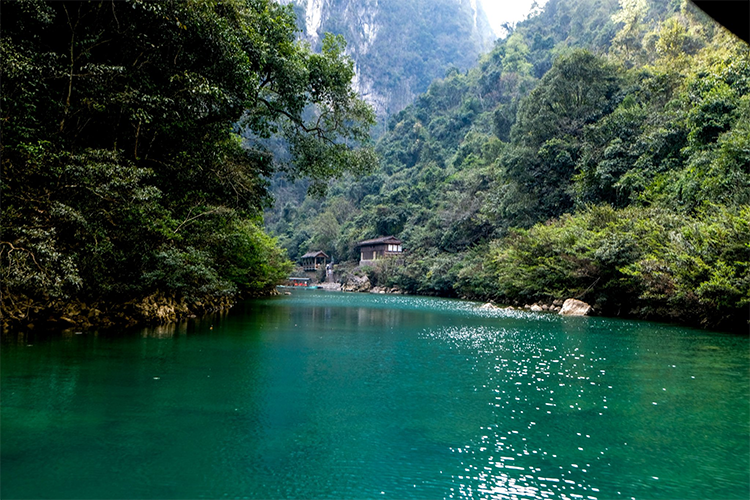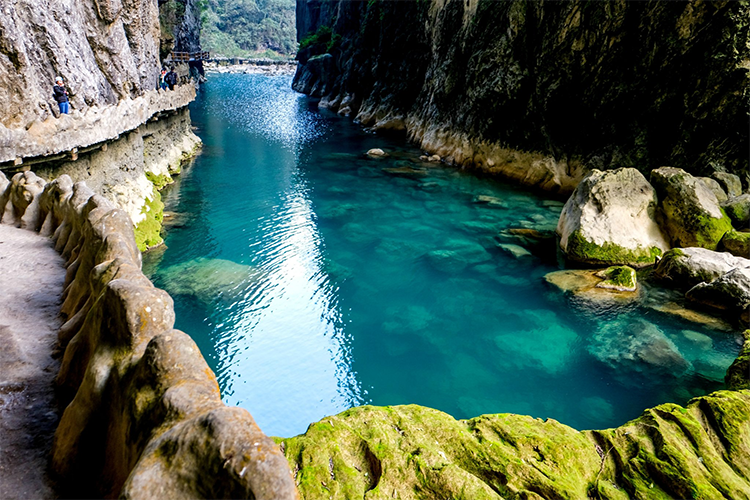Explore Libo’s Big Seven Holes Gorge: Essential Visitor Guide
Introduction:
When sunlight filters through the dense primeval forest and glitters on the blue-green Zhangjiang River, the cliffs of the Big Seven Holes Gorge glow with a golden sheen. This is a karst masterpiece — a towering natural stone bridge spans the canyon, subterranean rivers roar through caves, and vertical cliffs look as if split by a giant axe. As a core site of the UNESCO South China Karst World Heritage, Daqikong (Big Seven Holes) is both a visual feast and a walking geology textbook.
1. Soul Scenery: A Natural Museum of Karst Landforms
“One bridge, one cave, one gorge — nature’s craftsmanship on full display.” Daqikong condenses the essence of karst into a compact 1.5-km gorge.
– Tiansheng (Natural) Bridge: This natural stone arch rises more than 80 meters — the product of millions of years of water erosion. From beneath the bridge, vines and ferns hang like a green curtain.
– Yaofeng Cave (Wind Cave): Step into cool, shadowed caverns where an underground river and waterfall thunder. Stalactites and formations shimmer under lights; local lore says the cave’s strange winds once frightened Qing-era craftsmen.
– Terror Gorge: In its narrowest section the canyon is only about 10 meters wide, with near-vertical walls that open to a sliver of sky. During the rainy season the rushing water intensifies the canyon’s dramatic power.
– Dige Palace: Inside this subterranean cave system, dense stalagmites and draperies create palace-like chambers. Visitors often cross dark waterways by boat for a true “earth-core” adventure.
Best time to visit: April to October (fuller rivers and lush vegetation). Avoid peak-heavy rain months in July–August when some paths may close.
2. Millennia-old Bridges and Geologic Stories
Daqikong is more than scenery — it carries human and geological history.
– Qing Dynasty Stone Bridge: The site’s name also refers to a seven-arch stone bridge built during the Daoguang era of the Qing dynasty. Its piers were cleverly sited on natural reefs and the bridge still serves villagers today.
– A Living Geology Lesson: Every fold, fissure, and cave in the gorge records the two-hundred-million-year dance between water and limestone. Geologists call these layers a cross-section of Earth’s rings.

3. Immersive Ways to Explore: From Easy Walks to Hidden Depths
– Classic route (2–3 hours): Park entrance → boat through Dige Palace → boardwalk walk (Tiansheng Bridge → Yaofeng Cave → Terror Gorge) → return. The boardwalk is gentle and family-friendly.
– Deeper experiences: Photographers should aim for early morning to capture the mist-wreathed blue-green canyon. Geology enthusiasts can book specialist guided talks in advance to learn cave formation processes.
– Ecological highlights: Monkeys and silver pheasants are commonly seen along the trails. In clear waters you may spot the rare Libo blind fish, endemic to karst underground rivers.
4. Practical Information: Getting There and Helpful Tips
– How to reach Daqikong:
– From Libo county seat: about a 30-minute drive (roughly 25 km) by self-drive or private car; tourist shuttle buses run about once an hour and take around 40 minutes.
– High-speed rail transfer: the nearest station is Libo Station; taxi from the station to the park costs about RMB 50.
– Tickets and services:
– Standard ticket: RMB 110 (includes the boat); student discounts available. Buy tickets in advance on the “Libo Zhangjiang Scenic Area” official website to skip lines.
– The park offers English-language guides and clear boardwalk signage; for a live guide, reserve ahead.
– Food and lodging:
– Near the exit find Buyei ethnic restaurants serving sour soup fish and five-color glutinous rice. For upscale stays, choose hotels in Libo town or boutique guesthouses along the Zhangjiang river.

5. Beat the Crowds: Off-peak Moments and Rainy-day Beauty
Peak periods like National Day and summer holidays draw big crowds. Tips to avoid congestion:
– Time your visit: arrive on a weekday before 8:00 AM or in the last two hours before closing; the softer light makes for beautiful photos.
– Rainy-day charm: light rain lifts mist through the gorge and increases waterfall flow for an ink-wash karst atmosphere — bring non-slip shoes.

Conclusion:
Daqikong’s Big Seven Holes Gorge reads like a frozen epic of Earth’s history, waiting to be measured by your footsteps. Whether you glide by boat through an underground palace or stand beneath a natural stone arch spanning the sky, this UNESCO karst wonder will leave you awed. Add it to your Guizhou secret-spot list — the World Heritage label is well deserved.


